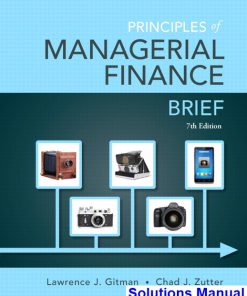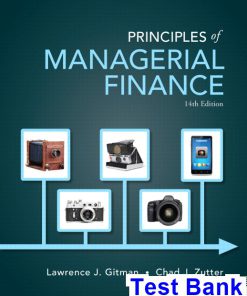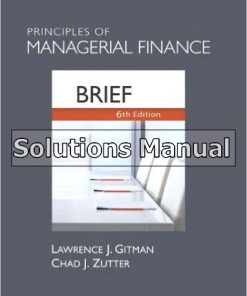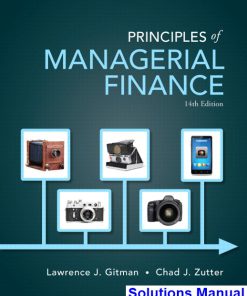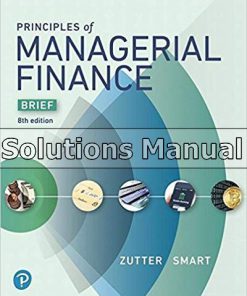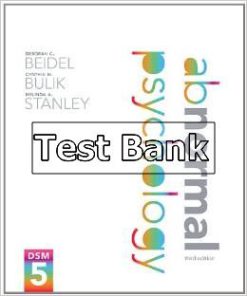Principles of Managerial Finance Brief 7th Edition Gitman Test Bank
$50.00 Original price was: $50.00.$26.50Current price is: $26.50.
Principles of Managerial Finance Brief 7th Edition Gitman Test Bank.
This is completed downloadable of Principles of Managerial Finance Brief 7th Edition Gitman Test Bank
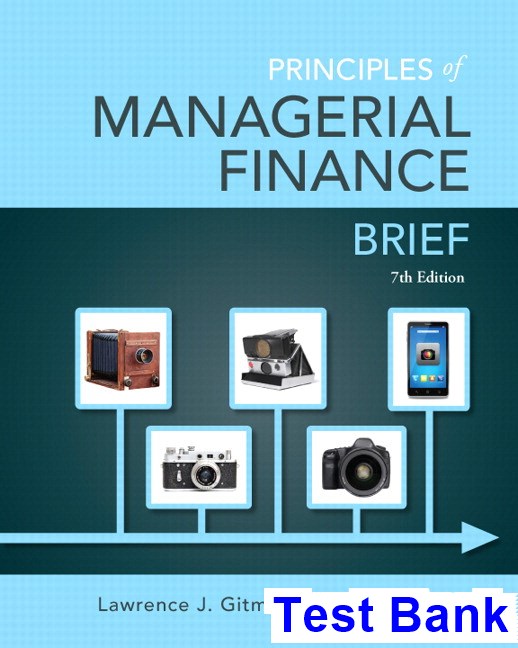
Product Details:
- ISBN-10 : 0133546403
- ISBN-13 : 978-0133546408
- Author: Lawrence J. Gitman (Author), Chad J. Zutter (Author)
Guide students through complex material with a proven learning goal system. This system – a hallmark feature of Principles of Managerial Finance, Brief—weaves pedagogy into concepts and practice, giving students a roadmap to follow through the text and supplementary tools.
Table of Content:
- Part 1 Introduction to Managerial Finance
- Chapters in This Part
- 1 The Role of Managerial Finance
- Learning Goals
- Why This Chapter Matters to You
- 1.1 Finance and Business
- WHAT IS FINANCE?
- CAREER OPPORTUNITIES IN FINANCE
- Financial Services
- Managerial Finance
- LEGAL FORMS OF BUSINESS ORGANIZATION
- Sole Proprietorships
- Partnerships
- Matter of fact
- BizStats.com Total Receipts by Type of U.S. Firm
- TABLE 1.1 Strengths and Weaknesses of the Common Legal Forms of Business Organization
- Corporations
- FIGURE 1.1 Corporate Organization
- Other Limited Liability Organizations
- WHY STUDY MANAGERIAL FINANCE?
- TABLE 1.2 Career Opportunities in Managerial Finance
- REVIEW QUESTIONS
- 1.2 Goal of the Firm
- MAXIMIZE SHAREHOLDER WEALTH
- MAXIMIZE PROFIT?
- FIGURE 1.2 Share Price Maximization
- Example 1.1
- Timing
- Cash Flows
- Risk
- WHAT ABOUT STAKEHOLDERS?
- THE ROLE OF BUSINESS ETHICS
- Matter of fact
- Considering Ethics
- ETHICS AND SHARE PRICE
- in practice focus on ETHICS: Critics See Ethical Dilemmas in Google Glass?
- REVIEW QUESTIONS
- 1.3 Managerial Finance Function
- ORGANIZATION OF THE FINANCE FUNCTION
- RELATIONSHIP TO ECONOMICS
- Example 1.2
- RELATIONSHIP TO ACCOUNTING
- Emphasis on Cash Flows
- Example 1.3
- Personal Finance Example 1.4
- Decision Making
- PRIMARY ACTIVITIES OF THE FINANCIAL MANAGER
- FIGURE 1.3 Financial Activities
- REVIEW QUESTIONS
- 1.4 Governance and Agency
- CORPORATE GOVERNANCE
- Individual versus Institutional Investors
- Government Regulation
- THE AGENCY ISSUE
- The Agency Problem
- Management Compensation Plans
- Matter of fact
- The Threat of Takeover
- REVIEW QUESTIONS
- Summary
- FOCUS ON VALUE
- REVIEW OF LEARNING GOALS
- Self-Test Problem
- Warm-up Exercises
- Problems
- Spreadsheet Exercise
- TO DO
- MyFinanceLab
- 2 The Financial Market Environment
- Learning Goals
- Why This Chapter Matters to You
- 2.1 Financial Institutions and Markets
- FINANCIAL INSTITUTIONS
- Key Customers of Financial Institutions
- Major Financial Institutions
- COMMERCIAL BANKS, INVESTMENT BANKS, AND THE SHADOW BANKING SYSTEM
- Matter of fact
- FINANCIAL MARKETS
- THE RELATIONSHIP BETWEEN INSTITUTIONS AND MARKETS
- FIGURE 2.1 Flow of Funds
- THE MONEY MARKET
- THE CAPITAL MARKET
- Key Securities Traded: Bonds and Stocks
- Example 2.1
- Broker Markets and Dealer Markets
- in practice focus on PRACTICE: Berkshire Hathaway: Can Buffett Be Replaced?
- International Capital Markets
- Matter of fact
- The Role of Capital Markets
- REVIEW QUESTIONS
- 2.2 The Financial Crisis
- FINANCIAL INSTITUTIONS AND REAL ESTATE FINANCE
- FALLING HOME PRICES AND DELINQUENT MORTGAGES
- FIGURE 2.2 House Prices Soar and then Crash
- CRISIS OF CONFIDENCE IN BANKS
- FIGURE 2.3 Bank Stocks Plummet During Financial Crisis
- SPILLOVER EFFECTS AND THE GREAT RECESSION
- REVIEW QUESTIONS
- 2.3 Regulation of Financial Institutions and Markets
- REGULATIONS GOVERNING FINANCIAL INSTITUTIONS
- REGULATIONS GOVERNING FINANCIAL MARKETS
- REVIEW QUESTIONS
- 2.4 Business Taxes
- ORDINARY INCOME
- Example 2.2
- Marginal versus Average Tax Rates
- TABLE 2.1 Corporate Tax Rate Schedule
- Interest and Dividend Income
- Tax-Deductible Expenses
- Example 2.3
- CAPITAL GAINS
- Example 2.4
- REVIEW QUESTIONS
- Summary
- THE ROLE OF FINANCIAL INSTITUTIONS AND MARKETS
- REVIEW OF LEARNING GOALS
- Self-Test Problem
- Warm-Up Exercises
- Problems
- Spreadsheet Exercise
- TO DO
- MyFinanceLab
- Part 2 Financial Tools
- Chapters in This Part
- 3 Financial Statements and Ratio Analysis
- Learning Goals
- Why This Chapter Matters to You
- 3.1 The Stockholders’ Report
- THE LETTER TO STOCKHOLDERS
- THE FOUR KEY FINANCIAL STATEMENTS
- Income Statement
- in practice focus on ETHICS: Taking Earnings Reports at Face Value
- TABLE 3.1 Bartlett Company Income Statements ($000)
- Personal Finance Example 3.1
- Balance Sheet
- TABLE 3.2 Bartlett Company Balance Sheets ($000)
- Personal Finance Example 3.2
- Statement of Retained Earnings
- TABLE 3.3 Bartlett Company Statement of Retained Earnings ($000) for the Year Ended December 31, 2015
- Statement of Cash Flows
- TABLE 3.4 Bartlett Company Statement of Cash Flows ($000) for the Year Ended December 31, 2015
- NOTES TO THE FINANCIAL STATEMENTS
- CONSOLIDATING INTERNATIONAL FINANCIAL STATEMENTS
- REVIEW QUESTIONS
- 3.2 Using Financial Ratios
- INTERESTED PARTIES
- TYPES OF RATIO COMPARISONS
- Cross-Sectional Analysis
- TABLE 3.5 Financial Ratios for Select Firms and Their Industry Median Values
- Example 3.3
- Time-Series Analysis
- Combined Analysis
- CAUTIONS ABOUT USING RATIO ANALYSIS
- FIGURE 3.1 Combined Analysis
- CATEGORIES OF FINANCIAL RATIOS
- REVIEW QUESTIONS
- 3.3 Liquidity Ratios
- CURRENT RATIO
- Matter of fact
- Personal Finance Example 3.4
- QUICK (ACID-TEST) RATIO
- Matter of fact
- REVIEW QUESTIONS
- 3.4 Activity Ratios
- INVENTORY TURNOVER
- AVERAGE COLLECTION PERIOD
- Matter of fact
- AVERAGE PAYMENT PERIOD
- TOTAL ASSET TURNOVER
- Matter of fact
- REVIEW QUESTION
- 3.5 Debt Ratios
- Example 3.5
- TABLE 3.6 Financial Statements Associated with Patty’s Alternatives
- DEBT RATIO
- DEBT-TO-EQUITY RATIO
- TIMES INTEREST EARNED RATIO
- FIXED-PAYMENT COVERAGE RATIO
- REVIEW QUESTIONS
- 3.6 Profitability Ratios
- COMMON-SIZE INCOME STATEMENTS
- GROSS PROFIT MARGIN
- OPERATING PROFIT MARGIN
- TABLE 3.7 Bartlett Company Common-Size Income Statements
- NET PROFIT MARGIN
- EARNINGS PER SHARE (EPS)
- RETURN ON TOTAL ASSETS (ROA)
- RETURN ON EQUITY (ROE)
- REVIEW QUESTIONS
- 3.7 Market Ratios
- PRICE/EARNINGS (P/E) RATIO
- MARKET/BOOK (M/B) RATIO
- REVIEW QUESTION
- 3.8 A Complete Ratio Analysis
- SUMMARIZING ALL RATIOS
- Liquidity
- Activity
- Debt
- Profitability
- Market
- DUPONT SYSTEM OF ANALYSIS
- DuPont Formula
- TABLE 3.8 Summary of Bartlett Company Ratios (2010–2015, Including 2015 Industry Averages)
- FIGURE 3.2 DuPont System of Analysis
- Modified DuPont Formula
- Matter of fact
- Applying the DuPont System
- Example 3.6
- REVIEW QUESTIONS
- Summary
- FOCUS ON VALUE
- REVIEW OF LEARNING GOALS
- Self-Test Problems
- Warm-Up Exercises
- Problems
- Spreadsheet Exercise
- TO DO
- MyFinanceLab
- 4 Cash Flow and Financial Planning
- Learning Goals
- Why This Chapter Matters to You
- 4.1 Analyzing the Firm’s Cash Flow
- DEPRECIATION
- Depreciable Value of an Asset
- Example 4.1
- Depreciable Life of an Asset
- TABLE 4.1 First Four Property Classes under MACRS
- DEPRECIATION METHODS
- TABLE 4.2 Rounded Depreciation Percentages by Recovery Year Using MACRS for First Four Property Classes
- Example 4.2
- DEVELOPING THE STATEMENT OF CASH FLOWS
- Classifying Inflows and Outflows of Cash
- Matter of fact
- TABLE 4.3 Inflows and Outflows of Cash
- Preparing the Statement of Cash Flows
- TABLE 4.4 Baker Corporation 2015 Income Statement ($000)
- TABLE 4.5 Baker Corporation Balance Sheets ($000)
- Interpreting the Statement
- TABLE 4.6 Baker Corporation Statement of Cash Flows ($000) for the Year Ended December 31, 2015
- Example 4.3
- FREE CASH FLOW
- Example 4.4
- Example 4.5
- REVIEW QUESTIONS
- in practice focus on PRACTICE: Free Cash Flow at Cisco Systems
- 4.2 The Financial Planning Process
- LONG-TERM (STRATEGIC) FINANCIAL PLANS
- SHORT-TERM (OPERATING) FINANCIAL PLANS
- FIGURE 4.1 Short-Term Financial Planning
- Personal Finance Example 4.6
- REVIEW QUESTIONS
- 4.3 Cash Planning: Cash Budgets
- THE SALES FORECAST
- PREPARING THE CASH BUDGET
- TABLE 4.7 The General Format of the Cash Budget
- Total Cash Receipts
- Example 4.7
- TABLE 4.8 A Schedule of Projected Cash Receipts for Coulson Industries ($000)
- Total cash disbursements
- Example 4.8
- TABLE 4.9 A Schedule of Projected Cash Disbursements for Coulson Industries ($000)
- Net Cash Flow, Ending Cash, Financing, and Excess Cash
- Example 4.9
- TABLE 4.10 A Cash Budget for Coulson Industries ($000)
- EVALUATING THE CASH BUDGET
- Personal Finance Example 4.10
- COPING WITH UNCERTAINTY IN THE CASH BUDGET
- Example 4.11
- TABLE 4.11 A Scenario Analysis of Coulson Industries’ Cash Budget ($000)
- CASH FLOW WITHIN THE MONTH
- REVIEW QUESTIONS
- 4.4 Profit Planning: Pro Forma Statements
- PRECEDING YEAR’S FINANCIAL STATEMENTS
- SALES FORECAST
- REVIEW QUESTIONS
- TABLE 4.12 Vectra Manufacturing’s Income Statement for the Year Ended December 31, 2015
- TABLE 4.13 Vectra Manufacturing’s Balance Sheet, December 31, 2015
- TABLE 4.14 2016 Sales Forecast for Vectra Manufacturing
- 4.5 Preparing the Pro Forma Income Statement
- CONSIDERING TYPES OF COSTS AND EXPENSES
- TABLE 4.15 A Pro Forma Income Statement, Using the Percent-of-Sales Method, for Vectra Manufacturing for the Year Ended December 31, 2016
- Example 4.12
- REVIEW QUESTIONS
- 4.6 Preparing the Pro Forma Balance Sheet
- TABLE 4.16 A Pro Forma Balance Sheet, Using the Judgmental Approach, for Vectra Manufacturing (December 31, 2016)
- REVIEW QUESTIONS
- 4.7 Evaluation of Pro Forma Statements
- REVIEW QUESTIONS
- Summary
- FOCUS ON VALUE
- REVIEW OF LEARNING GOALS
- Self-Test Problems
- Warm-Up Exercises
- Problems
- Spreadsheet Exercise
- TO DO
- MyFinanceLab
- 5 Time Value of Money
- Learning Goals
- Why This Chapter Matters to You
- 5.1 The Role of Time Value in Finance
- FUTURE VALUE VERSUS PRESENT VALUE
- FIGURE 5.1 Time Line
- FIGURE 5.2 Compounding and Discounting
- COMPUTATIONAL TOOLS
- Financial Calculators
- FIGURE 5.3 Calculator Keys
- Electronic Spreadsheets
- Cash Flow Signs
- BASIC PATTERNS OF CASH FLOW
- REVIEW QUESTIONS
- 5.2 Single Amounts
- FUTURE VALUE OF A SINGLE AMOUNT
- The Concept of Future Value
- Personal Finance Example 5.1
- The Equation for Future Value
- Personal Finance Example 5.2
- Personal Finance Example 5.3
- A Graphical View of Future Value
- FIGURE 5.4 Future Value Relationship
- PRESENT VALUE OF A SINGLE AMOUNT
- The Concept of Present Value
- Personal Finance Example 5.4
- The Equation for Present Value
- Personal Finance Example 5.5
- A Graphical View of Present Value
- REVIEW QUESTIONS
- FIGURE 5.5 Present Value Relationship
- EXCEL REVIEW QUESTIONS
- 5.3 Annuities
- TYPES OF ANNUITIES
- Personal Finance Example 5.6
- TABLE 5.1 Comparison of Ordinary Annuity and Annuity Due Cash Flows ($1,000, 5 Years)
- FINDING THE FUTURE VALUE OF AN ORDINARY ANNUITY
- Personal Finance Example 5.7
- FINDING THE PRESENT VALUE OF AN ORDINARY ANNUITY
- Example 5.8
- TABLE 5.2 Long Method for Finding the Present Value of an Ordinary Annuity
- FINDING THE FUTURE VALUE OF AN ANNUITY DUE
- Personal Finance Example 5.9
- Comparison of an Annuity Due with an Ordinary Annuity Future Value
- FINDING THE PRESENT VALUE OF AN ANNUITY DUE
- Example 5.10
- Comparison of an Annuity Due with an Ordinary Annuity Present Value
- Matter of fact
- FINDING THE PRESENT VALUE OF A PERPETUITY
- Personal Finance Example 5.11
- REVIEW QUESTIONS
- EXCEL REVIEW QUESTIONS
- 5.4 Mixed Streams
- FUTURE VALUE OF A MIXED STREAM
- Example 5.12
- PRESENT VALUE OF A MIXED STREAM
- Example 5.13
- REVIEW QUESTION
- EXCEL REVIEW QUESTIONS
- 5.5 Compounding Interest More Frequently Than Annually
- SEMIANNUAL COMPOUNDING
- Personal Finance Example 5.14
- TABLE 5.3 Future Value from Investing $100 at 8% Interest Compounded Semiannually over 24 Months (2 Years)
- QUARTERLY COMPOUNDING
- Personal Finance Example 5.15
- TABLE 5.4 Future Value from Investing $100 at 8% Interest Compounded Quarterly over 24 Months (2 Years)
- TABLE 5.5 Future Value at the End of Years 1 and 2 from Investing $100 at 8% Interest, Given Various Compounding Periods
- A GENERAL EQUATION FOR COMPOUNDING MORE FREQUENTLY THAN ANNUALLY
- Personal Finance Example 5.16
- USING COMPUTATIONAL TOOLS FOR COMPOUNDING MORE FREQUENTLY THAN ANNUALLY
- Personal Finance Example 5.17
- CONTINUOUS COMPOUNDING
- Personal Finance Example 5.18
- NOMINAL AND EFFECTIVE ANNUAL RATES OF INTEREST
- Personal Finance Example 5.19
- REVIEW QUESTIONS
- EXCEL REVIEW QUESTIONS
- 5.6 Special Applications of Time Value
- DETERMINING DEPOSITS NEEDED TO ACCUMULATE A FUTURE SUM
- Personal Finance Example 5.20
- LOAN AMORTIZATION
- Personal Finance Example 5.21
- TABLE 5.6 Loan Amortization Schedule ($6,000 Principal, 10% Interest, 4-Year Repayment Period)
- in practice focus on PRACTICE: New Century Brings Trouble for Subprime Mortgages
- FINDING INTEREST OR GROWTH RATES
- Personal Finance Example 5.22
- Personal Finance Example 5.23
- FINDING AN UNKNOWN NUMBER OF PERIODS
- Personal Finance Example 5.24
- Personal Finance Example 5.25
- REVIEW QUESTIONS
- EXCEL REVIEW QUESTIONS
- Summary
- FOCUS ON VALUE
- REVIEW OF LEARNING GOALS
- Self-Test Problems
- Warm-Up Exercises
- Problems
- Spreadsheet Exercise
- TO DO
- MyFinanceLab
- Part 3 Valuation of Securities
- Chapters in This Part
- 6 Interest Rates and Bond Valuation
- Learning Goals
- Why This Chapter Matters to You
- 6.1 Interest Rates and Required Returns
- INTEREST RATE FUNDAMENTALS
- Matter of fact
- The Real Rate of Interest
- FIGURE 6.1 Supply–Demand Relationship
- Nominal or Actual Rate of Interest (Return)
- Personal Finance Example 6.1
- FIGURE 6.2 Impact of Inflation
- TERM STRUCTURE OF INTEREST RATES
- Yield Curves
- FIGURE 6.3 Treasury Yield Curves
- Matter of fact
- Theories of Term Structure
- Expectations Theory
- Example 6.2
- Liquidity Preference Theory
- Market Segmentation Theory
- RISK PREMIUMS: ISSUER AND ISSUE CHARACTERISTICS
- Example 6.3
- TABLE 6.1 Debt-Specific Risk Premium Components
- REVIEW QUESTIONS
- 6.2 Corporate Bonds
- LEGAL ASPECTS OF CORPORATE BONDS
- Bond Indenture
- Standard Provisions
- Restrictive Provisions
- Sinking-Fund Requirements
- Security Interest
- Trustee
- COST OF BONDS TO THE ISSUER
- Impact of Bond Maturity
- Impact of Offering Size
- Impact of Issuer’s Risk
- Impact of the Cost of Money
- GENERAL FEATURES OF A BOND ISSUE
- BOND YIELDS
- BOND PRICES
- TABLE 6.2 Data on Selected Bonds
- BOND RATINGS
- in practice focus on ETHICS: Can We Trust the Bond Raters?
- TABLE 6.3 Moody’s and Standard & Poor’s Bond Ratings
- COMMON TYPES OF BONDS
- INTERNATIONAL BOND ISSUES
- TABLE 6.4 Characteristics and Priority of Lender’s Claim of Traditional Types of Bonds
- REVIEW QUESTIONS
- TABLE 6.5 Characteristics of Contemporary Types of Bonds
- 6.3 Valuation Fundamentals
- KEY INPUTS
- Cash Flows (Returns)
- Personal Finance Example 6.4
- Timing
- Risk and Required Return
- Personal Finance Example 6.5
- BASIC VALUATION MODEL
- Personal Finance Example 6.6
- REVIEW QUESTIONS
- 6.4 Bond Valuation
- BOND FUNDAMENTALS
- Example 6.7
- BASIC BOND VALUATION
- Personal Finance Example 6.8
- BOND VALUE BEHAVIOR
- Required Returns and Bond Values
- Example 6.9
- FIGURE 6.4 Bond Values and Required Returns
- TABLE 6.6 Bond Values for Various Required Returns (Mills Company’s 10% Coupon Interest Rate, 10-Year Maturity, $1,000 Par, January 1, 2014, Issue Date, Paying Annual Interest)
- Time to Maturity and Bond Values
- Constant Required Returns
- Example 6.10
- FIGURE 6.5 Time to Maturity and Bond Values
- Changing Required Returns
- Example 6.11
- YIELD TO MATURITY (YTM)
- Personal Finance Example 6.12
- SEMIANNUAL INTEREST AND BOND VALUES
- Example 6.13
- REVIEW QUESTIONS
- EXCEL REVIEW QUESTIONS
- Summary
- FOCUS ON VALUE
- REVIEW OF LEARNING GOALS
- Self-Test Problems
- Warm-Up Exercises
- Problems
- Spreadsheet Exercise
- TO DO
- MyFinanceLab
- 7 Stock Valuation
- Learning Goals
- Why This Chapter Matters to You
- 7.1 Differences between Debt and Equity
- VOICE IN MANAGEMENT
- CLAIMS ON INCOME AND ASSETS
- Matter of fact
- TABLE 7.1 Key Differences between Debt and Equity
- MATURITY
- TAX TREATMENT
- REVIEW QUESTION
- 7.2 Common and Preferred Stock
- COMMON STOCK
- Ownership
- Par Value
- Preemptive Rights
- Authorized, Outstanding, and Issued Shares
- Example 7.1
- Voting Rights
- Dividends
- International Stock Issues
- Matter of fact
- PREFERRED STOCK
- Basic Rights of Preferred Stockholders
- Features of Preferred Stock
- Restrictive Covenants
- Cumulation
- Other Features
- ISSUING COMMON STOCK
- Venture Capital
- Organization and Investment Stages
- TABLE 7.2 Organization of Venture Capital Investors
- Deal Structure and Pricing
- Going Public
- FIGURE 7.1 Cover of a Preliminary Prospectus for a Stock Issue
- The Investment Banker’s Role
- REVIEW QUESTIONS
- FIGURE 7.2 The Selling Process for a Large Security Issue
- 7.3 Common Stock Valuation
- MARKET EFFICIENCY
- Matter of fact
- THE EFFICIENT-MARKET HYPOTHESIS
- The Behavioral Finance Challenge
- BASIC COMMON STOCK VALUATION EQUATION
- in practice focus on PRACTICE: Understanding Human Behavior Helps Us Understand Investor Behavior
- Zero-Growth Model
- Personal Finance Example 7.2
- Preferred Stock Valuation
- Constant-Growth Model
- Example 7.3
- Variable-Growth Model
- Personal Finance Example 7.4
- TABLE 7.3 Calculation of Present Value of Warren Industries Dividends (2016–2018)
- FREE CASH FLOW VALUATION MODEL
- Example 7.5
- TABLE 7.4 Dewhurst, Inc.’s, Data for the Free Cash Flow Valuation Model
- TABLE 7.5 Calculation of the Value of the Entire Company for Dewhurst, Inc.
- OTHER APPROACHES TO COMMON STOCK VALUATION
- Book Value
- Example 7.6
- Liquidation Value
- Example 7.7
- Price/Earnings (P/E) Multiples
- Personal Finance Example 7.8
- Matter of fact
- REVIEW QUESTIONS
- 7.4 Decision Making and Common Stock Value
- FIGURE 7.3 Decision Making and Stock Value
- CHANGES IN EXPECTED DIVIDENDS
- Example 7.9
- CHANGES IN RISK
- Example 7.10
- COMBINED EFFECT
- Example 7.11
- REVIEW QUESTIONS
- Summary
- FOCUS ON VALUE
- REVIEW OF LEARNING GOALS
- Self-Test Problems
- Warm-Up Exercises
- Problems
- Spreadsheet Exercise
- TO DO
- MyFinanceLab
- Part 4 Risk and the Required Rate of Return
- Chapters in This Part
- 8 Risk and Return
- Learning Goals
- Why This Chapter Matters to You
- 8.1 Risk and Return Fundamentals
- RISK DEFINED
- in practice focus on ETHICS: If It Seems Too Good to Be True, It Probably Is
- RETURN DEFINED
- Example 8.1
- TABLE 8.1 Historical Returns on Selected Investments (1900–2011)
- RISK PREFERENCES
- REVIEW QUESTIONS
- 8.2 Risk of a Single Asset
- RISK ASSESSMENT
- Scenario Analysis
- Example 8.2
- TABLE 8.2 Assets A and B
- Probability Distributions
- Matter of fact
- Example 8.3
- FIGURE 8.1 Bar Charts
- RISK MEASUREMENT
- FIGURE 8.2 Continuous Probability Distributions
- Standard Deviation
- Example 8.4
- TABLE 8.3 Expected Values of Returns for Assets A and B
- Example 8.5
- TABLE 8.4 The Calculation of the Standard Deviation of the Returns for Assets A and B
- TABLE 8.5 Historical Returns and Standard Deviations on Selected Investments (1900–2011)
- Historical Returns and Risk
- Matter of fact
- Normal Distribution
- FIGURE 8.3 Bell-Shaped Curve
- Example 8.6
- Coefficient of Variation: Trading off Risk and Return
- Example 8.7
- Personal Finance Example 8.8
- REVIEW QUESTIONS
- 8.3 Risk of a Portfolio
- PORTFOLIO RETURN AND STANDARD DEVIATION
- Example 8.9
- Example 8.10
- TABLE 8.6 Expected Return, Expected Value, and Standard Deviation of Returns for Portfolio XY
- CORRELATION
- DIVERSIFICATION
- FIGURE 8.4 Correlations
- FIGURE 8.5 Diversification
- Example 8.11
- TABLE 8.7 Forecasted Returns, Expected Values, and Standard Deviations for Assets X, Y, and Z and Portfolios XY and XZ
- CORRELATION, DIVERSIFICATION, RISK, AND RETURN
- Example 8.12
- FIGURE 8.6 Possible Correlations
- INTERNATIONAL DIVERSIFICATION
- Returns from International Diversification
- Risks of International Diversification
- REVIEW QUESTIONS
- 8.4 Risk and Return: The Capital Asset Pricing Model (CAPM)
- TYPES OF RISK
- THE MODEL: CAPM
- FIGURE 8.7 Risk Reduction
- Beta Coefficient
- Deriving Beta from Return Data
- FIGURE 8.8 Beta Derivationa
- TABLE 8.8 Selected Beta Coefficients and Their Interpretations
- Interpreting Betas
- TABLE 8.9 Beta Coefficients for Selected Stocks (May 20, 2013)
- Portfolio Betas
- Personal Finance Example 8.13
- TABLE 8.10 Mario Austino’s Portfolios V and W
- The Equation
- Historical Risk Premiums
- Example 8.14
- The Graph: The Security Market Line (SML)
- Example 8.15
- FIGURE 8.9 Security Market Line
- Shifts in the Security Market Line
- Changes in Inflationary Expectations
- Example 8.16
- Changes in Risk Aversion
- FIGURE 8.10 Inflation Shifts SML
- Example 8.17
- Some Comments on the CAPM
- FIGURE 8.11 Risk Aversion Shifts SML
- REVIEW QUESTIONS
- Summary
- FOCUS ON VALUE
- REVIEW OF LEARNING GOALS
- Self-Test Problems
- Warm-up Exercises
- Problems
- Spreadsheet Exercise
- To Do
- MyFinanceLab
- 9 The Cost of Capital
- Learning Goals
- Why This Chapter Matters to You
- 9.1 Overview of the Cost of Capital
- THE BASIC CONCEPT
- Example 9.1
- SOURCES OF LONG-TERM CAPITAL
- REVIEW QUESTIONS
- 9.2 Cost of Long-Term Debt
- NET PROCEEDS
- Example 9.2
- BEFORE-TAX COST OF DEBT
- Using Market Quotations
- Calculating the Cost
- Example 9.3
- Approximating the Cost
- Example 9.4
- AFTER-TAX COST OF DEBT
- Example 9.5
- Personal Finance Example 9.6
- REVIEW QUESTIONS
- EXCEL REVIEW QUESTION
- 9.3 Cost of Preferred Stock
- PREFERRED STOCK DIVIDENDS
- CALCULATING THE COST OF PREFERRED STOCK
- Example 9.7
- REVIEW QUESTION
- 9.4 Cost of Common Stock
- FINDING THE COST OF COMMON STOCK EQUITY
- Using the Constant-Growth Valuation (Gordon Growth) Model
- Example 9.8
- Using the Capital Asset Pricing Model (CAPM)
- Example 9.9
- Comparing Constant-Growth and CAPM Techniques
- COST OF RETAINED EARNINGS
- Example 9.10
- Matter of fact
- COST OF NEW ISSUES OF COMMON STOCK
- Example 9.11
- REVIEW QUESTIONS
- 9.5 Weighted Average Cost of Capital
- CALCULATING WEIGHTED AVERAGE COST OF CAPITAL (WACC)
- Example 9.12
- WEIGHTING SCHEMES
- Book Value versus Market Value
- TABLE 9.1 Calculation of the Weighted Average Cost of Capital for Duchess Corporation
- in practice focus on PRACTICE: Uncertain Times Make for an Uncertain Weighted Average Cost of Capital
- Historical versus Target Weights
- Personal Finance Example 9.13
- REVIEW QUESTIONS
- Summary
- FOCUS ON VALUE
- REVIEW OF LEARNING GOALS
- Self-Test Problem
- Warm-Up Exercises
- Problems
- Spreadsheet Exercise
- TO DO
- MyFinanceLab
- Part 5 Long-Term Investment Decisions
- Chapters in This Part
- 10 Capital Budgeting Techniques
- Learning Goals
- Why This Chapter Matters to You
- 10.1 Overview of Capital Budgeting
- MOTIVES FOR CAPITAL EXPENDITURE
- STEPS IN THE PROCESS
- BASIC TERMINOLOGY
- Independent versus Mutually Exclusive Projects
- Unlimited Funds versus Capital Rationing
- Accept–Reject versus Ranking Approaches
- CAPITAL BUDGETING TECHNIQUES
- Bennett Company’s Relevant Cash Flows
- REVIEW QUESTION
- 10.2 Payback Period
- TABLE 10.1 Capital Expenditure Data for Bennett Company
- FIGURE 10.1 Bennett Company’s Projects A and B
- DECISION CRITERIA
- Example 10.1
- PROS AND CONS OF PAYBACK ANALYSIS
- Matter of fact
- Personal Finance Example 10.2
- TABLE 10.2 Relevant Cash Flows and Payback Periods for DeYarman man Enterprises’ Projects
- Example 10.3
- Example 10.4
- TABLE 10.3 Calculation of the Payback Period for Rashid Company’s Two Alternative Investment Projects
- REVIEW QUESTIONS
- 10.3 Net Present Value (NPV)
- DECISION CRITERIA
- Example 10.5
- FIGURE 10.2 Calculation of NPVs for Bennett Company’s Capital Expenditure Alternatives
- Project A
- Project B
- NPV AND THE PROFITABILITY INDEX
- Example 10.6
- NPV AND ECONOMIC VALUE ADDED
- Example 10.7
- REVIEW QUESTIONS
- EXCEL REVIEW QUESTION
- 10.4 Internal Rate of Return (IRR)
- DECISION CRITERIA
- CALCULATING THE IRR
- Example 10.8
- FIGURE 10.3 Calculation of IRRs for Bennett Company’s Capital Expenditure Alternatives
- Personal Finance Example 10.9
- REVIEW QUESTIONS
- EXCEL REVIEW QUESTION
- 10.5 Comparing NPV and IRR Techniques
- NET PRESENT VALUE PROFILES
- Example 10.10
- TABLE 10.4 Discount Rate–NPV Coordinates for Projects A and B
- FIGURE 10.4 NPV Profiles
- CONFLICTING RANKINGS
- Reinvestment Assumption
- Example 10.11
- TABLE 10.5 Reinvestment Rate Comparisons for a Project
- TABLE 10.6 Project Cash Flows after Reinvestment
- Timing of the Cash Flow
- TABLE 10.7 Ranking Projects A and B Using IRR and NPV Methods
- Magnitude of the Initial Investment
- WHICH APPROACH IS BETTER?
- Theoretical View
- Practical View
- Matter of fact
- in practice focus on ETHICS: Nonfinancial Considerations in Project Selection
- REVIEW QUESTIONS
- Summary
- FOCUS ON VALUE
- REVIEW OF LEARNING GOALS
- Self-Test Problem
- Warm-up Exercises
- Problems
- Spreadsheet Exercise
- TO DO
- MyFinanceLab
- 11 Capital Budgeting Cash Flows and Risk Refinements
- Learning Goals
- Why This Chapter Matters to You
- 11.1 Relevant Cash Flows
- in practice focus on ETHICS: A Question of Accuracy
- MAJOR CASH FLOW COMPONENTS
- EXPANSION VERSUS REPLACEMENT DECISIONS
- FIGURE 11.1 Cash Flow Components
- FIGURE 11.2 Relevant Cash Flows for Replacement Decisions
- SUNK COSTS AND OPPORTUNITY COSTS
- Example 11.1
- Matter of fact
- REVIEW QUESTIONS
- 11.2 Finding the Initial Investment
- INSTALLED COST OF NEW ASSET
- TABLE 11.1 The Basic Format for Determining Initial Investment
- AFTER-TAX PROCEEDS FROM SALE OF OLD ASSET
- Book Value
- Example 11.2
- Basic Tax Rules
- Example 11.3
- TABLE 11.2 Tax Treatment on Sales of Assets
- The sale of the asset for more than its book value
- FIGURE 11.3 Taxable Income from Sale of Asset
- The sale of the asset for its book value
- The sale of the asset for less than its book value
- CHANGE IN NET WORKING CAPITAL
- Matter of fact
- Example 11.4
- TABLE 11.3 Calculation of Change in Net Working Capital for Danson Company
- CALCULATING THE INITIAL INVESTMENT
- Example 11.5
- REVIEW QUESTIONS
- 11.3 Finding the Operating Cash Flows
- INTERPRETING THE TERM AFTER-TAX
- INTERPRETING THE TERM CASH FLOWS
- Example 11.6
- TABLE 11.4 Powell Corporation’s Revenue and Expenses (Excluding Depreciation and Interest) for Proposed and Present Machines
- TABLE 11.5 Depreciation Expense for Proposed and Present Machines for Powell Corporation
- TABLE 11.6 Calculation of Operating Cash Flows Using the Income Statement Format
- TABLE 11.7 Calculation of Operating Cash Flows for Powell Corporation’s Proposed and Present Machines
- INTERPRETING THE TERM INCREMENTAL
- TABLE 11.8 Incremental (Relevant) Operating Cash Flows for Powell Corporation
- Example 11.7
- REVIEW QUESTIONS
- 11.4 Finding the Terminal Cash Flow
- PROCEEDS FROM SALE OF ASSETS
- TAXES ON SALE OF ASSETS
- TABLE 11.9 The Basic Format for Determining Terminal Cash Flow
- CHANGE IN NET WORKING CAPITAL
- Example 11.8
- REVIEW QUESTION
- 11.5 Risk in Capital Budgeting (Behavioral Approaches)
- TABLE 11.10 Relevant Cash Flows and NPVs for Bennett Company’s Projects
- BREAKEVEN ANALYSIS
- Example 11.9
- SCENARIO ANALYSIS
- Example 11.10
- TABLE 11.11 Scenario Analysis of Treadwell’s Projects A and B
- SIMULATION
- FIGURE 11.4 NPV Simulation
- REVIEW QUESTIONS
- EXCEL REVIEW QUESTION MyFinanceLab
- 11.6 Risk-Adjusted Discount Rates
- DETERMINING RISK-ADJUSTED DISCOUNT RATES (RADRS)
- Personal Finance Example 11.11
- Review of CAPM
- Using CAPM to Find RADRs
- FIGURE 11.5 CAPM and SML
- Example 11.12
- APPLYING RADRS
- Example 11.13
- FIGURE 11.6 Calculation of NPVS for Bennett Company’s Capital Expenditure Alternatives Using RADRs
- PORTFOLIO EFFECTS
- RADRS IN PRACTICE
- TABLE 11.12 Bennett Company’s Risk Classes and RADRs
- Example 11.14
- REVIEW QUESTIONS
- 11.7 Capital Budgeting Refinements
- COMPARING PROJECTS WITH UNEQUAL LIVES
- The Problem
- Example 11.15
- Annualized Net Present Value (ANPV) Approach
- Example 11.16
- RECOGNIZING REAL OPTIONS
- TABLE 11.13 Major Types of Real Options
- Example 11.17
- CAPITAL RATIONING
- Internal Rate of Return Approach
- Example 11.18
- FIGURE 11.7 Investment Opportunities Schedule
- Net Present Value Approach
- Example 11.19
- TABLE 11.14 Rankings for Tate Company Projects
- REVIEW QUESTIONS
- EXCEL REVIEW QUESTION MyFinanceLab
- Summary
- REVIEW OF LEARNING GOALS
- Self-Test Problems
- Warm-Up Exercises
- Problems
- Risk Classes and RADRs
- Spreadsheet Exercise
- TO DO
- MyFinanceLab
- Part 6 Long-Term Financial Decisions
- Chapters in This Part
- 12 Leverage and Capital Structure
- Learning Goals
- Why This Chapter Matters to You
- 12.1 Leverage
- TABLE 12.1 General Income Statement Format and Types of Leverage
- BREAKEVEN ANALYSIS
- Algebraic Approach
- TABLE 12.2 Operating Leverage, Costs, and Breakeven Analysis
- Example 12.1
- FIGURE 12.1 Breakeven Analysis
- Graphical Approach
- Changing Costs and the Operating Breakeven Point
- TABLE 12.3 Sensitivity of Operating Breakeven Point to Increases in Key Breakeven Variables
- Example 12.2
- Personal Finance Example 12.3
- FIGURE 12.2 Operating Leverage
- OPERATING LEVERAGE
- Example 12.4
- TABLE 12.4 The EBIT for Various Sales Levels
- Measuring the Degree of Operating Leverage (DOL)
- Example 12.5
- Example 12.6
- in practice focus on PRACTICE: Adobe’s Leverage
- Fixed Costs and Operating Leverage
- Example 12.7
- FINANCIAL LEVERAGE
- TABLE 12.5 Operating Leverage and Increased Fixed Costs
- Example 12.8
- TABLE 12.6 The EPS for Various EBIT Levelsa
- Measuring the Degree of Financial Leverage (DFL)
- Example 12.9
- Personal Finance Example 12.10
- Example 12.11
- TOTAL LEVERAGE
- Example 12.12
- TABLE 12.7 The Total Leverage Effect
- Measuring the Degree of Total Leverage (DTL)
- Example 12.13
- Example 12.14
- Relationship of Operating, Financial, and Total Leverage
- Example 12.15
- REVIEW QUESTIONS
- 12.2 The Firm’s Capital Structure
- TYPES OF CAPITAL
- EXTERNAL ASSESSMENT OF CAPITAL STRUCTURE
- TABLE 12.8 Median Debt Ratios for Selected Industries (Fiscal Year 2011)
- Personal Finance Example 12.16
- CAPITAL STRUCTURE OF NON–U.S. FIRMS
- Matter of fact
- CAPITAL STRUCTURE THEORY
- Tax Benefits
- Probability of Bankruptcy
- Business Risk
- Example 12.17
- TABLE 12.9 Sales and Associated EBIT Calculations for Cooke Company ($000)
- Total Risk
- Example 12.18
- TABLE 12.10 Capital Structures Associated with Alternative Debt Ratios for Cooke Company
- TABLE 12.11 Level of Debt, Interest Rate, and Dollar Amount of Annual Interest Associated with Cooke Company’s Alternative Capital Structures
- TABLE 12.12 Calculation of EPS for Selected Debt Ratios ($000) for Cooke Company
- TABLE 12.13 Expected EPS, Standard Deviation, and Coefficient of Variation for Alternative Capital Structures for Cooke Company
- FIGURE 12.3 Probability Distributions
- FIGURE 12.4 Expected EPS and Coefficient of Variation of EPS
- Agency Costs Imposed by Lenders
- Asymmetric Information
- Pecking Order Theory
- Signaling Theory
- OPTIMAL CAPITAL STRUCTURE
- FIGURE 12.5 Cost Functions and Value
- Cost Functions
- Graphical View of Optimal Structure
- REVIEW QUESTIONS
- 12.3 EbIT–EPS Approach to Capital Structure
- PRESENTING A FINANCING PLAN GRAPHICALLY
- Data Required
- Example 12.19
- Plotting the Data
- FIGURE 12.6 EBIT–EPS Approach
- COMPARING ALTERNATIVE CAPITAL STRUCTURES
- Example 12.20
- CONSIDERING RISK IN EBIT–EPS ANALYSIS
- Example 12.21
- BASIC SHORTCOMING OF EBIT–EPS ANALYSIS
- REVIEW QUESTION
- 12.4 Choosing the Optimal Capital Structure
- LINKAGE
- TABLE 12.14 Required Returns for Cooke Company’s Alternative Capital Structures
- Example 12.22
- ESTIMATING VALUE
- Example 12.23
- TABLE 12.15 Calculation of Share Value Estimates Associated with Alternative Capital Structures for Cooke Company
- MAXIMIZING VALUE VERSUS MAXIMIZING EPS
- FIGURE 12.7 Estimating Value
- Example 12.24
- SOME OTHER IMPORTANT CONSIDERATIONS
- TABLE 12.16 Important Factors to Consider in Making Capital Structure Decisions
- REVIEW QUESTIONS
- Summary
- FOCUS ON VALUE
- REVIEW OF LEARNING GOALS
- Self-Test Problems
- Warm-Up Exercises
- Problems
- Spreadsheet Exercise
- TO DO
- MyFinanceLab
- 13 Payout Policy
- Learning Goals
- Why This Chapter Matters to You
- 13.1 The Basics of Payout Policy
- ELEMENTS OF PAYOUT POLICY
- TRENDS IN EARNINGS AND DIVIDENDS
- FIGURE 13.1 Per Share Earnings and Dividends of the S&P 500 Index
- Matter of fact
- TRENDS IN DIVIDENDS AND SHARE REPURCHASES
- FIGURE 13.2 Aggregate Dividends and Repurchases for All U.S.–Listed Companies
- in practice focus on ETHICS: Are Buybacks Really a Bargain?
- Matter of fact
- REVIEW QUESTIONS
- 13.2 The Mechanics of Payout Policy
- FIGURE 13.3 U.S. Public Industrial Firms Increasing, Decreasing, or Maintaining Dividends
- CASH DIVIDEND PAYMENT PROCEDURES
- Example 13.1
- FIGURE 13.4 Dividend Payment Time Line
- SHARE REPURCHASE PROCEDURES
- Example 13.2
- TAX TREATMENT OF DIVIDENDS AND REPURCHASES
- Personal Finance Example 13.3
- DIVIDEND REINVESTMENT PLANS
- STOCK PRICE REACTIONS TO CORPORATE PAYOUTS
- REVIEW QUESTIONS
- 13.3 Relevance of Payout Policy
- RESIDUAL THEORY OF DIVIDENDS
- THE DIVIDEND IRRELEVANCE THEORY
- ARGUMENTS FOR DIVIDEND RELEVANCE
- REVIEW QUESTIONS
- 13.4 Factors Affecting Dividend Policy
- LEGAL CONSTRAINTS
- Example 13.4
- Example 13.5
- CONTRACTUAL CONSTRAINTS
- GROWTH PROSPECTS
- OWNER CONSIDERATIONS
- MARKET CONSIDERATIONS
- REVIEW QUESTION
- 13.5 Types of Dividend Policies
- CONSTANT-PAYOUT-RATIO DIVIDEND POLICY
- Example 13.6
- REGULAR DIVIDEND POLICY
- Example 13.7
- LOW-REGULAR-AND-EXTRA DIVIDEND POLICY
- REVIEW QUESTION
- 13.6 Other Forms of Dividends
- STOCK DIVIDENDS
- Accounting Aspects
- Example 13.8
- Shareholder’s Viewpoint
- Example 13.9
- The Company’s Viewpoint
- STOCK SPLITS
- Example 13.10
- Personal Finance Example 13.11
- REVIEW QUESTIONS
- Summary
- FOCUS ON VALUE
- REVIEW OF LEARNING GOALS
- Self-Test Problem
- Warm-Up Exercises
- Problems
- Spreadsheet Exercise
- TO DO
- MyFinanceLab
- Part 7 Short-Term Financial Decisions
- Chapters in This Part
- 14 Working Capital and Current Assets Management
- Learning Goals
- Why This Chapter Matters to You
- 14.1 Net Working Capital Fundamentals
- WORKING CAPITAL MANAGEMENT
- Matter of fact
- NET WORKING CAPITAL
- TRADE-OFF BETWEEN PROFITABILITY AND RISK
- Changes in Current Assets
- TABLE 14.1 Effects of Changing Ratios on Profits and Risk
- FIGURE 14.1 Yearly Medians for All U.S.–Listed Manufacturing Companies
- Changes in Current Liabilities
- REVIEW QUESTIONS
- 14.2 Cash Conversion Cycle
- CALCULATING THE CASH CONVERSION CYCLE
- Matter of fact
- Example 14.1
- FUNDING REQUIREMENTS OF THE CASH CONVERSION CYCLE
- FIGURE 14.2 Time Line for Whirlpool’s Cash Conversion Cycle
- Permanent versus Seasonal Funding Needs
- Example 14.2
- FIGURE 14.3 Semper Pump Company’s Total Funding Requirements
- Aggressive versus Conservative Seasonal Funding Strategies
- Example 14.3
- STRATEGIES FOR MANAGING THE CASH CONVERSION CYCLE
- REVIEW QUESTIONS
- 14.3 Inventory Management
- DIFFERING VIEWPOINTS ABOUT INVENTORY LEVEL
- COMMON TECHNIQUES FOR MANAGING INVENTORY
- ABC System
- Economic Order Quantity (EOQ) Model
- Mathematical Development of EOQ
- Personal Finance Example 14.4
- Reorder Point
- Example 14.5
- Just-in-Time (JIT) System
- in practice focus on PRACTICE: RFID: The Wave of the Future?
- Computerized Systems for Resource Control
- INTERNATIONAL INVENTORY MANAGEMENT
- REVIEW QUESTIONS
- 14.4 Accounts Receivable Management
- CREDIT SELECTION AND STANDARDS
- Five C’s of Credit
- Credit Scoring
- Changing Credit Standards
- Example 14.6
- Making the Credit Standard Decision
- Example 14.7
- Managing International Credit
- TABLE 14.2 Effects on Dodd Tool of a Relaxation of Credit Standards
- CREDIT TERMS
- Cash Discount
- Example 14.8
- TABLE 14.3 Analysis of Initiating a Cash Discount for MAX Company
- Cash Discount Period
- Credit Period
- CREDIT MONITORING
- Average Collection Period
- Aging of Accounts Receivable
- Example 14.9
- Popular Collection Techniques
- TABLE 14.4 Popular Collection Techniques
- REVIEW QUESTIONS
- 14.5 Management of Receipts and Disbursements
- FLOAT
- SPEEDING UP COLLECTIONS
- Matter of fact
- SLOWING DOWN PAYMENTS
- CASH CONCENTRATION
- ZERO-BALANCE ACCOUNTS
- Personal Finance Example 14.10
- INVESTING IN MARKETABLE SECURITIES
- REVIEW QUESTIONS
- TABLE 14.5 Features of Popular Marketable Securities
- Summary
- FOCUS ON VALUE
- REVIEW OF LEARNING GOALS
- Self-Test Problems
- Warm-Up Exercises
- Problems
- Spreadsheet Exercise
- TO DO
- MyFinanceLab
- 15 Current Liabilities Management
- Learning Goals
- Why This Chapter Matters to You
- 15.1 Spontaneous Liabilities
- ACCOUNTS PAYABLE MANAGEMENT
- Role in the Cash Conversion Cycle
- Example 15.1
- Analyzing Credit Terms
- Taking the Cash Discount
- Example 15.2
- Giving Up the Cash Discount
- FIGURE 15.1 Payment Options
- Example 15.3
- Using the Cost of Giving Up a Cash Discount in Decision Making
- Example 15.4
- TABLE 15.1 Cash Discounts and Associated Costs for Mason Products
- Effects of Stretching Accounts Payable
- Example 15.5
- Personal Finance Example 16.6
- ACCRUALS
- in practice focus on ETHICS: Accruals Management
- Example 15.7
- REVIEW QUESTIONS
- 15.2 Unsecured Sources of Short-Term Loans
- BANK LOANS
- Loan Interest Rates
- Fixed- and Floating-Rate Loans
- Method of Computing Interest
- Example 15.8
- Single-Payment Notes
- Example 15.9
- Personal Finance Example 15.10
- Lines of Credit
- Interest Rates
- Operating-Change Restrictions
- Compensating Balances
- Example 15.11
- Annual Cleanups
- Revolving Credit Agreements
- Example 15.12
- COMMERCIAL PAPER
- Interest on Commercial Paper
- Example 15.13
- Matter of fact
- INTERNATIONAL LOANS
- International Transactions
- Financing International Trade
- Transactions between Subsidiaries
- REVIEW QUESTIONS
- 15.3 Secured Sources of Short-Term Loans
- CHARACTERISTICS OF SECURED SHORT-TERM LOANS
- Collateral and Terms
- Institutions Extending Secured Short-Term Loans
- USE OF ACCOUNTS RECEIVABLE AS COLLATERAL
- Pledging Accounts Receivable
- The Pledging Process
- Notification
- Matter of fact
- Pledging Cost
- Factoring Accounts Receivable
- Factoring Agreement
- Matter of fact
- Factoring Cost
- USE OF INVENTORY AS COLLATERAL
- Floating Inventory Liens
- Trust Receipt Inventory Loans
- Warehouse Receipt Loans
- REVIEW QUESTIONS
- Summary
- FOCUS ON VALUE
- REVIEW OF LEARNING GOALS
- Self-Test Problem
- Warm-Up Exercises
- Problems
- Spreadsheet Exercise
- TO DO
- MyFinanceLab
- Back Matter
- Appendix Solutions to Self-Test Problems
- Chapter 1
- Chapter 2
- Chapter 3
- Chapter 4
- Chapter 5
- Chapter 6
- Chapter 7
- Chapter 8
- Chapter 9
- Chapter 10
- Chapter 11
- Chapter 12
- Chapter 13
- Chapter 14
- Chapter 15
- Glossary
- Index
- FREQUENTLY USED SYMBOLS AND ABBREVIATIONS
- MyFinanceLab™
- The Key to Your Success in Three Easy Steps!
- If your instructor assigns homework and tests using MyFinanceLab
People Also Search:
principles of managerial finance brief gitman
principles of managerial finance brief 7th edition gitman
principles of managerial finance brief 7th edition
principles of managerial finance brief 7th edition download scribd
principles of managerial finance brief 7th edition testbank download pdf
Instant download after Payment is complete
You may also like…
Solutions Manual
Principles of Managerial Finance Brief 8th Edition Zutter Test Bank




